In this project, we will create a Prezi presentation based on just an idea. Often, people have an idea for a presentation they have to build, but they don't have any idea about what the exact content should be. They end up including a lot of details and are not able to build a clear structure for their presentation.
A good presentation consists of a clear message, a few main topics, and a clear structure for all the information.
Brainstorming is ideal to generate ideas and content (diverge), but don't forget to mark the main ideas and get rid of the information you don't really need (converge). Divergent thinking is about expanding your ideas, looking for alternatives, quantity, trial and error, chaos, and intuition. With divergent thinking, you can explore as many aspects of a concept as possible. Convergent thinking is about focus, selecting ideas, choosing, structuring, organizing, quality, and logic. Convergent thinking is the opposite of divergent thinking.
It's important to create a distinction between the main topics and the details. Ideally, you should have three main topics. That's enough. Not all information is of the same importance. You'll have main topics, subtopics, and details. The result of our structuring session is a clear mind map (in Prezi!) that we will use as a basis for our presentation in Prezi.
Using a mind map for your Prezi presentation is the easiest way to use Prezi in a good way. This way of presenting always works, because you zoom in for the details and zoom out for the overview.

Brainstorming is a great way to develop the content for your presentation. Put your brains to work and you will be able to come up with the best and creative ideas. Yes, you too can be creative! It's easy. Just follow this project and you'll learn to generate ideas in Prezi and create a great prezi out of it.
We'll also keep you from falling into the trap of trying to brainstorm and structure at the same time, as that would just complicate things. In this project, you will learn how to first diverge, converge, and finally fill in the details.
We have no special needs for this project. We'll keep it fast and simple, and we'll be only using Prezi.
The only thing we need to start off is an idea. To make sure that we focus on the process and not too much on the subject itself, we decided to choose a light subject for this project. The subject should trigger your brain so that ideas start popping up immediately. Our first idea is to create a presentation about "The Future". This should give you some inspiration!
What about goal, message, and audience? If you think we are forgetting something in the process of creating a presentation, you could be right. Every presentation should start with the following three questions in order to define the goal, message, and audience of the presentation:
What do I want to achieve with this presentation? (goal)
What do I want the audience to remember? (message)
Who is the audience?
Most people never ask these questions and immediately start creating and designing their presentation. If you are not asking yourself what the goal of your presentation is, and if you don't define it, you can never meet that goal and your presentation might never be a success.
However, the focus of this project is on brainstorming, mind mapping, and being creative; therefore, we will not ask these questions yet. The aim of this project is to practice brainstorming and structuring and therefore, we will leave out these three very important questions.
You can look at this project as a free presentation assignment to practice presenting. This could not only be a project for school, but also for the company or organization in which you work. In this project, we'll start with the brainstorming and we'll define our goal, message, and audience later.
We use our idea "The Future" as a starting point for our presentation. We could immediately start in Prezi, but sometimes it's better not to start directly with a computer. First, we need to free our mind.
Before you start brainstorming, it's a good idea to free your mind and get ready for some creativity. Pick one task from the following list. Choose the one you never do (or do the least).
Stand up and take a five-minute walk
Listen to the sounds around you really carefully for five minutes
Sing your favorite song from your childhood
Empty your Lego box on the table and start building something
Play a game of darts or pool
Watch a funny YouTube movie
Run around crazily for one minute
Laugh out loud for at least one full minute
Buy and eat an ice cream
Starting your brainstorm is like preparing for a new task. Brainstorming is fun but also requires hard work. Make sure you are in the right mood, free your mind, and stay focused. You don't have to be relaxed to be creative as a lot of people think, you need to be active.
Now you're ready to start your brainstorm in Prezi.
Let's start brainstorming in Prezi.
Open a new prezi, choose a blank template, and delete all the objects on the canvas. Make sure your canvas is completely empty before you start brainstorming as shown in the next screenshot:
Of course, you can delete the frame by clicking on it and deleting it, but you can also use the key combination Ctrl + A and press Backspace on your keyboard.

We will start our brainstorm by putting our first idea on the canvas. So, click on the canvas and type The Future. Make sure the text style is Body.
A few ideas will probably start popping up in your mind immediately. Type these ideas on the canvas. It doesn't matter where you put these ideas on the canvas. However, it is preferable if you don't put them too close to each other and definitely not in a straight line.

It's important to know that everything that pops up in your mind is okay. It's okay to put everything on the canvas. It's not yet the time to decide if a word is okay or not. The word popped up in your mind, so it's okay. It's that simple and no one should judge that, not even you.
Make use of the infinite canvas of Prezi. The canvas is larger than you think. If the area looks full, pan the canvas (click on the canvas and drag it) to create more room.
At a certain moment, one word may attract your attention. Zoom in to that word (using the plus sign at the right side of the screen), forget the first idea, and start brainstorming about that word—just that word. We zoomed in to the word history. When you're done, zoom out by clicking on the small house at the right side of the screen and continue brainstorming, or you can zoom in to another word and start brainstorming about that word.

Let this process continue for as long as you want. It's okay to stop for a while or to continue a whole day.
You shouldn't go looking for images or videos as that would break your creativity. If you think of an image, just put the word that the image describes on the canvas.
One last important thing: make the important words big and the details small. You can play around with this and just follow your feeling. The words of the main topics don't have to be of the same height. If one main topic is a bit more important than another main topic, make that first main topic a bit bigger. People will immediately understand that because they see it. They might not be aware of it, but their eyes (actually their brains) see what's more important.
Your final brainstorm could look like the following screenshot:

In this task, we made our first brainstorm in Prezi. First, we put our initial idea on the canvas and then we just started typing words that popped up in our mind. The most important thing of this process is that everything you type is okay. Later on, you can decide which words will stay and which words need to be removed. Sometimes, you zoom into a word and continue brainstorming on just that word. The bigger a word, the more important that word is to you. The main goal of this task is to let the words flow.
When people are creating their presentation, they try to do all things at the same time: think of the content, fill in the content, design the presentation, think of the story to tell, and create the presentation. That doesn't work. These are different processes. You should handle one process at a time. When you are thinking of the content, don't try to design your presentation; similarly, when you are thinking of the story to tell don't try to fill in the content. So, when you are brainstorming, just brainstorm. Don't try to think about how the presentation should look like; that's a different process.
Our next task is to turn our brainstorm into a useful mind map. In this process, we need to structure our information, get rid of the information we don't need, and decide which topics will be our main topics. When we limit the number of main topics to three, we'll reach the core of our information.
First, we will mark our starting point in our brainstorm (the first idea and our temporary title) and the main topics. We'll use the Prezi text styles for this.
Double-click on the first idea The Future, choose the text style Title, and make this text big (if it's not already big enough). Use the bigger A in the menu to enlarge the text or click on the small circle in the bottom-right corner of the text box as shown in the following screenshot:
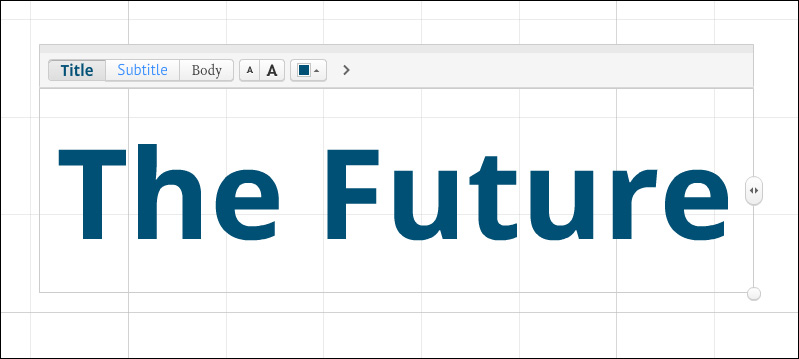
Tip
Resizing text
You have two options to resize text: inside the text box (editing mode) or via the transformation tool. If you are inside the text box (by double-clicking on the text), you can resize the text by using the small or bigger A or the small circle in the bottom-right corner of the text box. Click on the text box once and use the transformation tool to resize the text. The plus sign is used to enlarge the text and the minus sign is used to minimize the text. You can also click-and-drag the small blue squares at the corner of the text box to resize text.
Now, choose your three most important words from all the words on the canvas. These will become your main topics. Double-click on these words and choose the text style Subtitle for them. Make these words bigger, but not as big as the title. This is shown in the following screenshot:
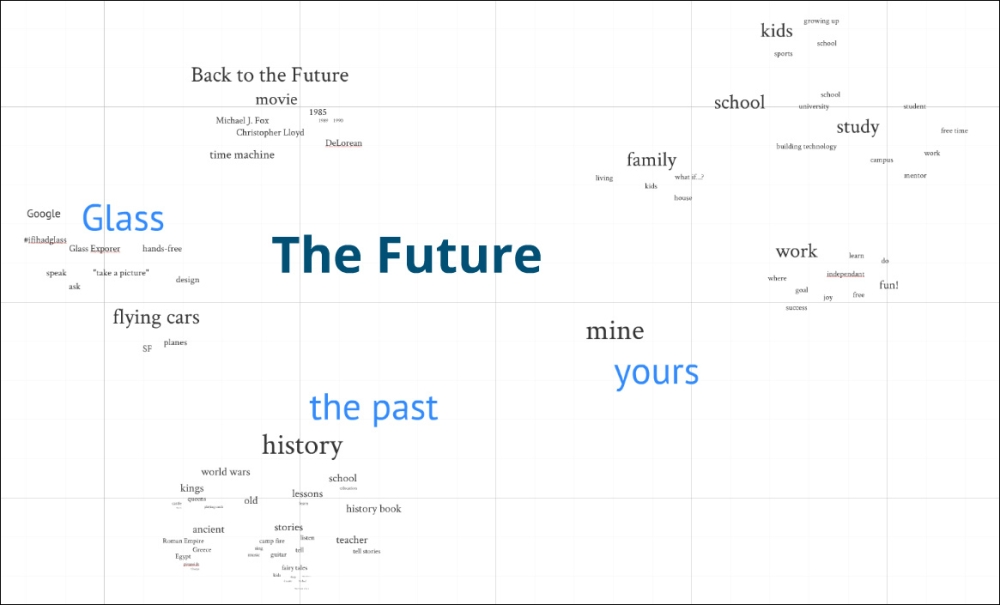
The next step is the most interesting one. For every other word on the canvas, decide whether it should be part of one of our main topics or remove the word. If a word is part of a main topic, move the word to that main topic. If new words pop up in your mind, it's okay to add them to the canvas.
When you finish this process, your canvas will look like the following screenshot. This is the information structure (or mind map) that will be the basis of your presentation.
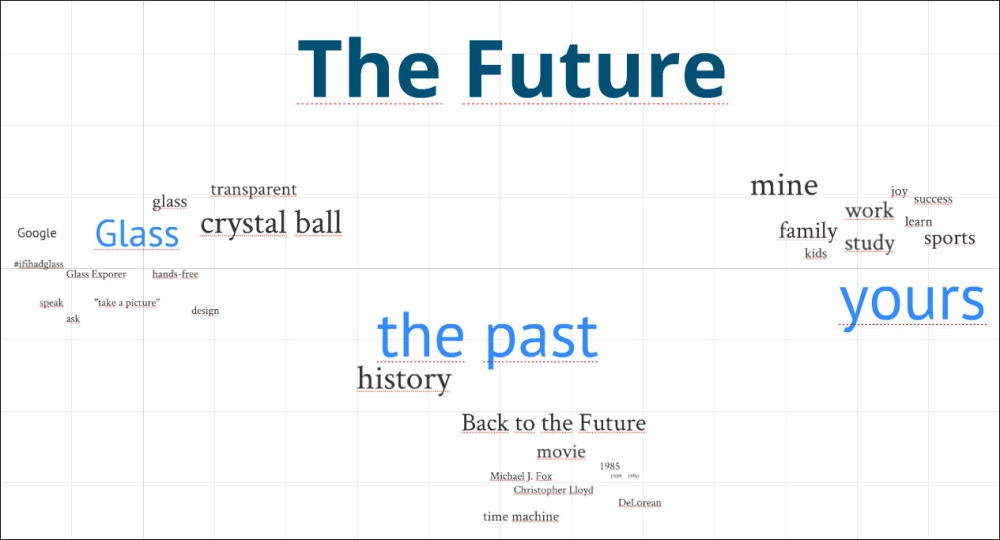
To show relations or to emphasize information, you can add arrows and lines or use the highlighter. This helps you to structure the information further and determine the objects on which you want to focus. It can also help you think about the flow of the information during your presentation.
Arrows and lines are for when you want to show relationships and associations. The highlighter is suitable when you want to emphasize any information. You can even make small drawings with the highlighter. Finally, for extra accentuation, you can also use an arrow that will point at the information, just like the red arrow that is shown in the following screenshot.
Tip
Creating a double-sided arrow is not a standard option in Prezi. So, if you need it, you have to create it yourself by using two separate arrows and putting them next to each other.
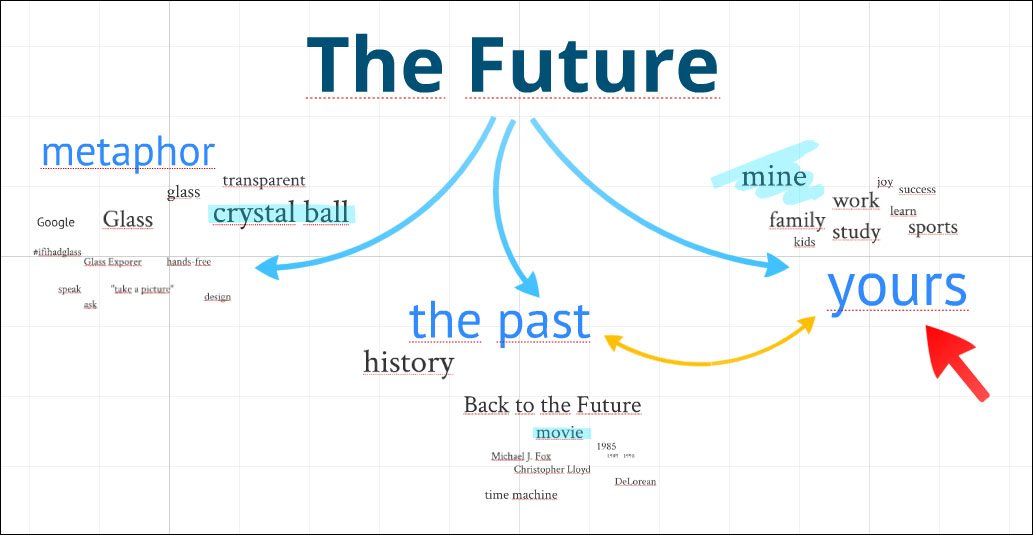
In this task, you learned how to turn your brainstorm into a mind map. You used Title for the subject and Subtitle for the three main topics. Our subject is The Future, our main topics are metaphor, the past, and yours.
Then, you decided for every other word whether it's a part of a main topic or it should be removed. It's an interesting process and a few new words might pop up in your mind. In our case, the word metaphor popped up during our process. A metaphor is a way of describing a subject as something else to make a stronger visual. We will be using a crystal ball as a metaphor for The Future.
The result of this process is a mind map for your presentation. You can use arrows, lines, and a highlighter to create relationships or emphasize information.
You can take your information structure a step further by using frames. Frames are a great way to visualize a structure. You can use frames to group content, so that if you move a frame, the entire content will move as well. This will enable you to rearrange the information really fast just by moving the frames. Not on paper and not even with post-its can you move information this easily. Use frames in frames to show subtopics and more detailed information.
Frames do not have to be of the same size. You can resize them in the same way as you resize text. The bigger a frame, the more important the information.
Our mind map would look like the following screenshot if we use frames:
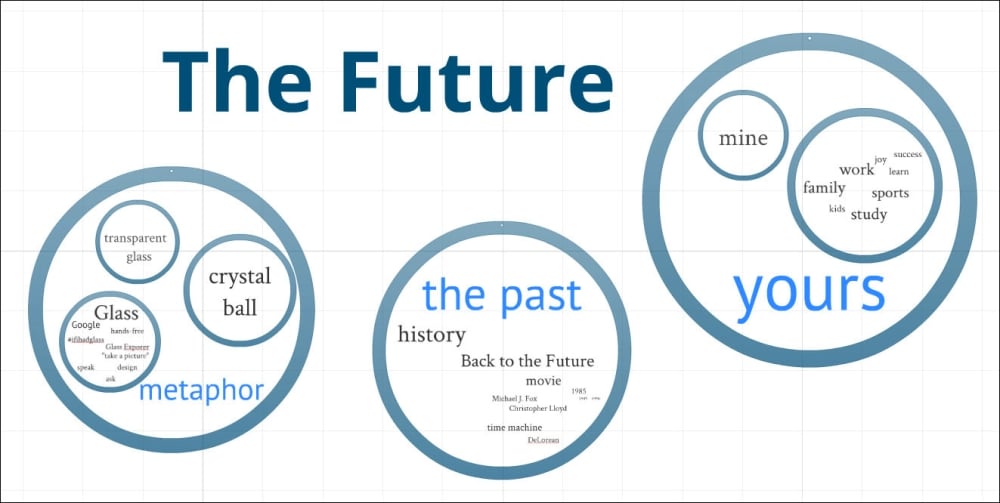
The most important work for our presentation is done. Just fill in the details and present them. Piece of cake!
What does filling in the details exactly mean? It's more than adding a few pictures to your prezi. It's a good idea to use images in your presentation, because you don't have to show in words what you tell. A picture can represent the exact meaning of the things you say, but it can also be a metaphor or a funny picture. Humor is great for presentations.
You don't have to use a picture for every word. Sometimes, you will use a combination of pictures and words. It's important to remember not to show too much at once. Most of the times, it's best to show just one picture or just one word.
Videos also work very well for presentations, because videos can put emotion in the presentations. They also create a quiet moment for you in the presentation when you can think of your next sentences or relax a bit.
So, have a look at your mind map in your prezi and go look for nice pictures and videos. Of course, you can take pictures and videos yourself, but you can also find a lot on the Internet. Make sure you don't violate any copyright laws. If you're not sure, don't use it. There are lots of stock photo sites out there where you can buy (cheap) fantastic material. We bought some pictures from iStockphoto.com.
As a metaphor for the future, we bought a nice picture of a crystal ball. It's a nice effect to show the crystal ball not in the beginning of the presentation but at the end—as a surprise. We'll start the presentation with our title The Future.
We are going from mind map to story. So, let's write down the flow of our presentation first.
We'll start with the text The Future. To make a jump to the past, but with a relation to the future, we'll show a small part of the famous movie Back to the Future. A few seconds is enough to start our presentation in a nice manner. Then, we'll talk a bit about the future, we'll show a picture of Google Glass, and we'll ask the audience what comes up in their mind when they think about the future. Next, we'll tell about our idea of future and how we think about our family, work, study, and sports in the future. We'll use this as an example for the audience. Then, we'll show the crystal ball as a metaphor because we can't predict the future. Finally, we'll ask the audience to think about their future. We could also ask the audience to grab a piece of paper and write it down to make the presentation more active.
Now, it's time for us to write down the answers to the three important questions we haven't answered yet:
What do I want to achieve with this presentation? (goal)
What do I want the audience to remember? (message)
Who is the audience?
The answers are as follows:
My personal goal is to create a better presentation using brainstorming techniques and to make the audience more active during my presentation.
I want the audience to say after my presentation, "This wasn't a boring presentation at all. It was actually really nice!"
My colleagues are the audience.
This is how we create the prezi. We'll start by explaining how we made the beginning and the end of the prezi.
Tip
What is a path?
With a path you create your storyline in Prezi. You can add every object to the path. When presenting, Prezi automatically zooms in to the objects you added to the path and puts them straight. Your path is the flow of your presentation. You can test your path with the Present button. You can click through it with the arrow keys or by using a remote.
To add an object to the path, you first open the path by clicking on the Edit Path button on the left-hand side of the screen. Then, just click on the object you want to add to the path and Prezi automatically adds the object to the path. A thumbnail appears for every step in the path. You can drag the thumbnails to change to order of the path.
The following steps show how to create the path step 1 and the last part of the presentation:
Insert a image of a crystal ball in your prezi.
Make it big and place the crystal ball under the mind map. You can also work inside the mind map. However, because this is the most important picture for the presentation and it's the end point of the prezi, we'll start a new prezi under the mind map.
Move (or copy) the text The Future inside the ball. Then, put the text yours under the crystal ball.
The crystal ball will be the last image of the presentation (zooming out) with an extra zooming out (extra surprise) the text yours? will become visible. Let's test this first.
Tip
Invisible frames
With frames, you can visually structure the content. This provides your audience with clarity and overview. Frames are also the stepping stones of the path you create to go through your prezi. However, sometimes you don't want all your frames to be visible, because a visible frame can also distract the audience. Then, you can create invisible frames. It works the same as the visible frames, but you don't see these frames in the presentation mode.
You create an invisible frame by selecting Draw Invisible Frame from Frames & Arrows and then clicking-and-dragging the frame on the canvas.
Draw an invisible frame around the crystal ball
Draw an extra invisible frame around the crystal ball and the text yours?.
Add the text The Future and the two invisible frames to the path
Test the path via the Present button
In the following screenshot, you'll see the path we've made so far in the Edit Path side bar on the left-hand side of the screen:
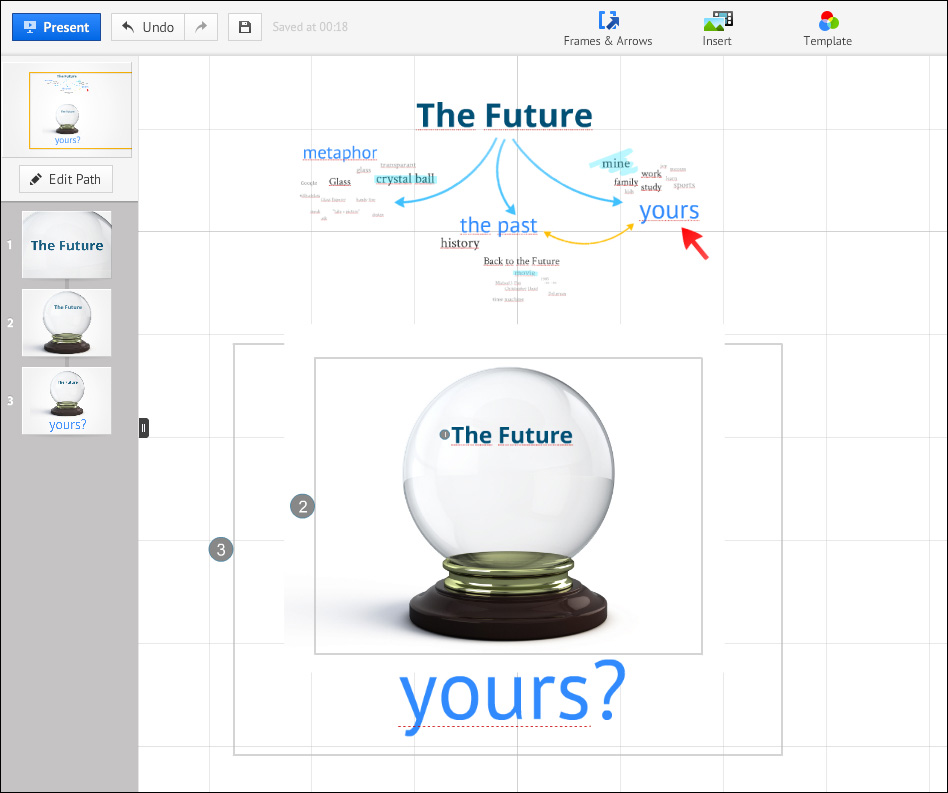
The beginning and the end of the presentation are ready. Now it's time to fill in the middle part.
The following steps should be performed to create path step 2:
Go to YouTube.com, search for "back to the future" and look for a nice fragment of video.
Copy the address of the YouTube movie and return to your prezi.
Navigate to Insert | YouTube video... and paste the address of the video in the text field.
Make the video smaller with the transformation tool to make it fit inside the character F.
Before you zoom out, add the video to the path and move it to path step two, as shown in the following screenshot:

The following steps should be performed to create path step 3:
Zoom out completely by clicking on the small house on the right side of the screen.
Navigate to Insert | Image, type
google glassin the search field, and mark the checkbox Search only images licensed for commercial use, as shown in the following screenshot:
Most of the pictures you'll find in this way are pictures from Wikipedia. To make sure that we are allowed to use this picture, we also search for this picture on the Internet using the query
google glass wikipedia. We find the source of this picture, read the license, and add the source to the picture.Add the picture to the path and move it to path step 3.
The following steps should be performed to create path step 4:
Now, copy (or move) the text of the main topic mine into the crystal ball. We then change the word mine to my future.
Draw an invisible frame around all these words and add it to the path.
Move it to path step 4.
To make our personal story more lively, we add a few pictures and a video to it. We also use some Prezi symbols (the computer and the smiley). You can find these symbols by navigating to Insert | Symbols & shapes.... We used the category Stickers.
For the section family, we copy two photo frames from a Prezi scrapbook template. To do this, perform the following steps:
Add a new tab in your browser by using the Ctrl/Command + T keys.
Find the scrapbook template on www.prezihotshot.com, open it in the new tab, and make a copy of this prezi by clicking on the button Make a copy. The scrapbook prezi will be copied to your account.
Open the prezi in the editor by clicking on the Edit button.
Select a photo frame and use the Ctrl/Command + C keys to copy it.
Click on the tab of your original prezi and paste the copied photo frame in it with Ctrl/Command + V.
Sometimes, we add the pictures or text directly to the path. We first draw an invisible frame around it and then add the invisible frame to the path, as shown in the following screenshot:
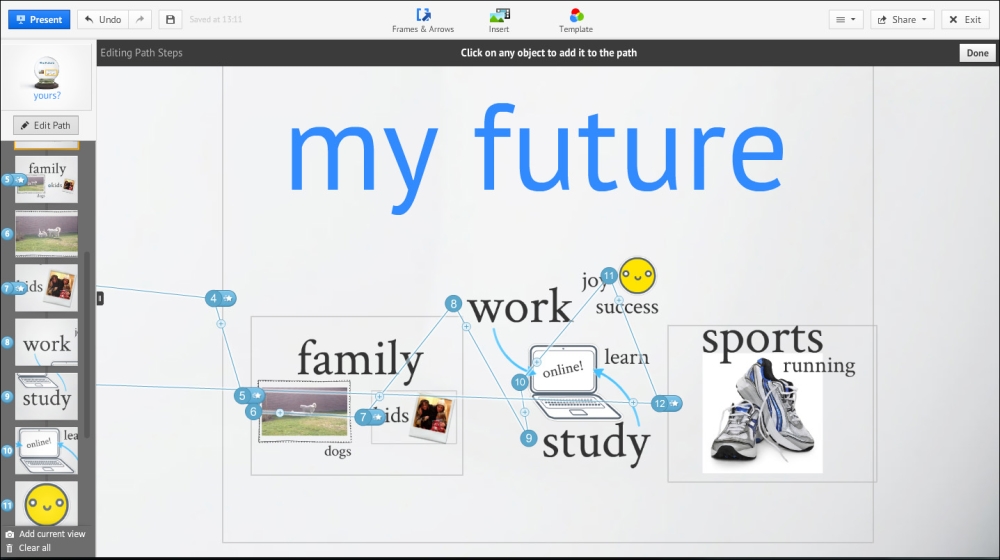
Of course, we need to remove our mind map from the canvas. The fastest way to remove the mind map is to hold down the Shift key and click and drag a rectangle around the mind map. Then, click on the Delete key.
You can also keep it in a separate prezi file if you want to save it. First, select the mind map by dragging a rectangle around it while holding down the Shift key. Then, copy the mind map with Ctrl/Command + C. Open a new prezi and paste the mind map in it with Ctrl/Command + V.
Our story in prezi is now complete. Watch it online at www.prezihotshot.com.
We went from a brainstorm with lots of words to a prezi with images, video, and a few words. In this task, we finally created our prezi.
We started with a nice image of a crystal ball. We started the prezi and made the last part of the prezi first. The crystal ball is the surprise at the end of the prezi.
Then, we filled in the content of our presentation. We used images and videos and created a nice flow.
If you use frames, it's even easier to fill in the details of your presentation and create a path. You can use the frame-based mind map as the basis and you can leave it as it is. You can only add pictures and videos to it and create a path.
Draw an invisible frame around the whole mind map and add this frame between every main topic in the path. This gives your audience an overview before you go to the next subject. For the overview, it's better to use an invisible frame; otherwise, this frame would attract too much attention and it also would bound the information too much. Now, the structure remains open and there's more attention for the three visible circle frames that represent the subjects.
Of course, you can also watch this prezi online at www.prezihotshot.com.
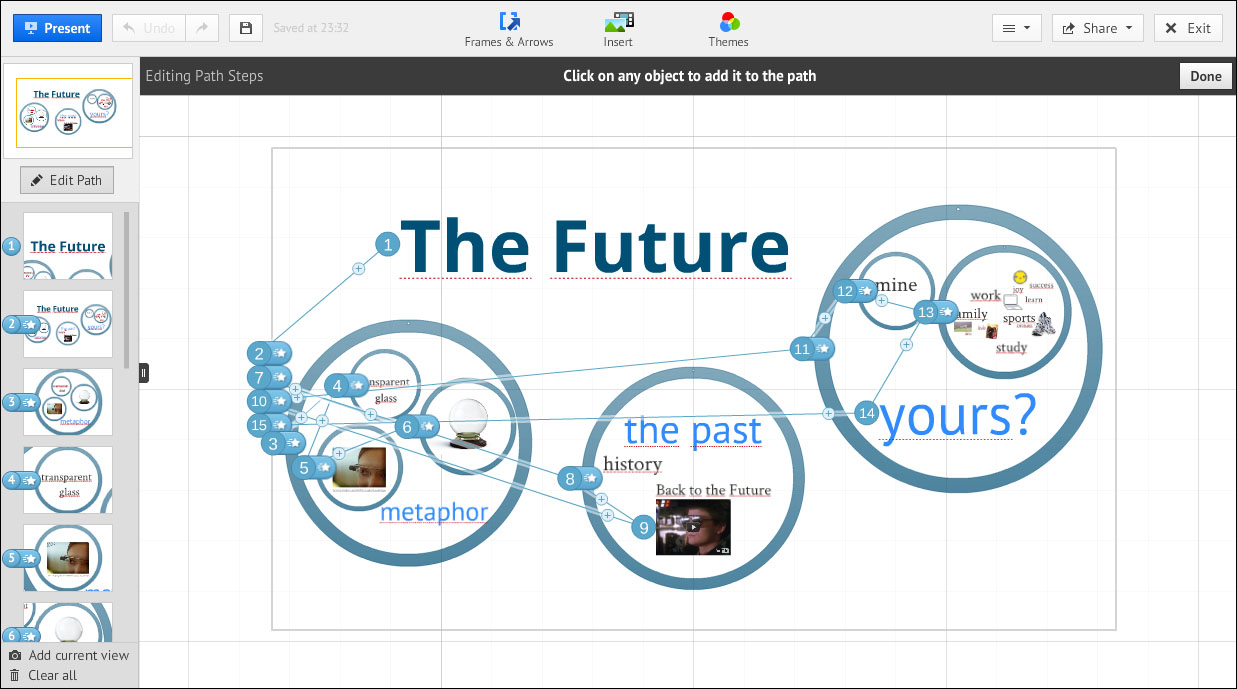
A lot of people present their prezi online. That's okay as long as you have a good and stable Internet connection. If you do not have a good Internet connection or if you're not sure about doing this, you better download your prezi for your presentation.
It doesn't matter which Prezi account you have. You can download your prezi and present it offline with any type of account. The YouTube videos you have added to your prezi cannot be played if you don't have an Internet connection. These movies are not inserted in to your prezi, it's a link to the YouTube movie. Other movies, which can be inserted by selecting From file (PDF, Video)... under Insert, will always play even without an Internet connection.
In your prezis, go to the prezi you want to download and click on the Download button. Click on Presenting (the one on the left-hand side) and then click on the Download button, as shown in the following screenshot. A ZIP file will download to your computer. This ZIP file contains everything you need to present, for both Windows and Mac. You don't need a browser and there is a built-in Flash Player.

Unzip the ZIP file and double-click on Prezi.exe if you are presenting on a Windows machine. The other prezi file is to present on a Mac.
The file will automatically open in the Flash Player. Click on the Fullscreen button in the bottom-right corner to show the prezi on a fullscreen as shown in the following screenshot. Now, you are ready to present!

If you want, you can use a remote to click through your presentation instead of using the keyboard arrows. A remote looks much more professional.
Note
Both the iPad and iPhone don't support Flash. However, you can download the free Prezi apps for both iPad and iPhone. Visit the links prezi.com/ipad/ and prezi.com/iphone/ for more information.
In this task, we explained how you can present your prezi without an Internet connection. It's okay to present online, but your Internet connection must be stable and have enough bandwidth. If it's not working well, it might slow down your presentation and lead to frustration both for you and your audience.
We started our presentation with just our first idea and we used the brainstorming technique to generate ideas for our presentation. We were concentrating on thinking up new ideas and generating content. Brainstorming is about diverging.
In the next step, we marked our title and the three main topics and also created the structure of our information. This is about converging information. For every word, we decided whether it was a part of one of the main topics or whether we should get rid of it.
The result of these steps was a clear mind map and information structure. We used it as the basis for our presentation. The last step was the filling in of details and getting ready to present it.

Now, you've seen how you can brainstorm and develop a structure in Prezi and create a presentation to practice these skills. Choose one of the following subjects, start your brainstorm, create a mind map, fill it with information, and present it to your friends and family!
My ideal house
When I dream, I think of…
My favorite food
When I'm old…
On an extra day off, I'll…




















